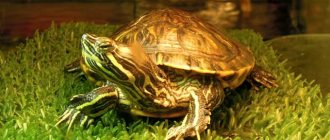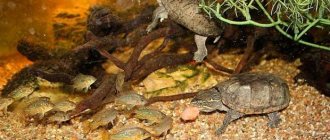Costa Rica
Playa Grande – This beautiful beach is one of the best places in the world to see huge turtles all year round. The nesting season for tanners is from October to March, so visiting during this time means you may see small turtles heading towards the water.
Playa Grande is the second largest turtle nesting site. But it is necessary to order a guide so as not to disturb their nesting habits and so that the eggs are not damaged.
Most tours suggest visiting late in the evening, usually after sunset, to ensure the safety of the turtles, but don't worry as your guide will show you everything you need to know and lots of other interesting information.
Where does the turtle live?
10/23/2020 Scientist cat Animals
Perhaps turtles are the animals that each of us has seen at least once in our lives. In a park by a pond, in a zoo, at the home of friends, acquaintances or relatives, or at least as a character in the old Soviet film “The Adventures of Pinocchio” or the cartoon “About a Lion Cub and a Turtle.” Have you ever wondered where a turtle lives? What does she eat? How often does it lay eggs?
Where does the turtle live? Land
Turtles, like all reptiles, are considered cold-blooded animals, which automatically means that they themselves are not able to regulate their own body temperature. Unlike, for example, birds or mammals, which are warm-blooded, they are more susceptible to fluctuations in ambient temperature.
Consequently, their habitats are more limited. These reptiles are unlikely to be found in regions with low air temperatures, beyond 40° of both southern and northern latitude, as well as in high mountain areas anywhere in the world. Why? If we look at this issue from a purely zoological point of view, then in such climatic conditions they would hardly be able to accumulate a sufficient amount of energy, obtain the amount of food necessary for normal existence, and also withstand prolonged phases of cold and dormancy.
Secondly, the phases of animal activity would be so short that they would hardly be enough for the usual annual reproduction. Purely physiologically, these reptiles, immediately after the end of the resting period, need, first of all, to eat very well in order to accumulate the strength necessary for mating and the development of eggs. In addition, it should be noted that energy will also be needed for incubation, from the time of laying eggs until the birth of turtles.
Land turtles prefer the tropics or subtropics to live; by the way, this is why the largest variety of species of these animals is found in Africa. On this continent alone there are 24 species, Asia lags far behind (8 species), but on both American continents, as well as in Europe, there are only 4.
Where does the turtle live? Marine
As a matter of fact, from the name alone one can assume that this creature does not live on land. That's right, the animal chose the depths of the sea as a place to live. Agree, a turtle swimming among colorful corals and colorful fish is a photo that very often becomes a screensaver for our computer desktops. And this is not surprising - yes, these animals are accustomed to living among such beauty. Being inhabitants of salt waters, unlike their land and freshwater relatives, they can boast of a large and sometimes simply enormous body size.
Their usual habitat is tropical waters; being cold-blooded animals, they almost never try to visit cold latitudes.
Where does the turtle live? A pet
Sometimes during the turtle sales season, frankly, my mood begins to deteriorate when I see these animals being carried home en masse from pet stores. I just want to say: “People, think about it. This animal is far from a toy! He needs care, no less than a kitten or puppy!”
Got a turtle at home? Then remember a few points.
- These reptiles are fed once every two or three days, otherwise they begin to suffer from increased obesity and eventually get sick.
- It is strictly forbidden to knock on the shell. Imagine if you were placed inside a bucket, and then they started hitting it with all their might. This is approximately what the poor animal feels.
- The turtle appears to be an indifferent and clumsy pet until you watch it and pay more attention.
- In the life of these reptiles, vision plays a huge role; even the turtle will choose food, first of all, relying on color and only then on smell or taste.
Source: fb.ru
animals, nature
Indonesia
The Indonesian Gili Islands are made up of three tiny islands. The islands are home to green turtles, which are vegetarian, and Hawksbill turtles, which are the most beautiful because of their colorful shells. The turtles are cared for under the protective eye of the island's Turtle Protection Center.
These tropical islands are good for divers, where you can dive approximately 10 meters below sea level. However, if you are not yet ready to dive, don't worry, you can snorkel with these beautiful species between March and September.
Natural enemies
Despite having a strong and reliable shell, turtles have quite a lot of enemies that pose a danger to the reptile not only on land, but also in the aquatic environment. The most important enemy of the turtle is man, who catches and kills such animals in order to obtain meat and eggs, as well as shell. Turtles are also affected by viral and fungal infections, ectoparasites and helminths.
This is interesting! Jaguars are good at preparing several turtles for their meal at once, which the predator turns over on a flat surface onto its back and removes from its shell using very sharp claws.
Turtles that live in water are hunted by predatory animals, including crabs and horse mackerel, large predatory fish and even sharks. Birds of prey are capable of dropping turtles from a fairly large height onto a rocky surface, after which they peck the animal from its split shell.
Return to content
Australia
The Sea Turtle Foundation recommends visiting Heron Island, which lies south of the Great Barrier Reef. During nesting periods here you can see both cormorants (which are predators) and green turtles.
On this island you can get a tour to learn more about turtles and watch them nest. Snorkeling is also a good way to see sea turtles. The best time to visit is spring-autumn.
Nutrition
Animal food should prevail in the diet of young red-eared turtles. It allows the turtles to grow even more actively. But it should be given no more than once a day. Place a variety of algae and other plants in the aquarium, as turtles will be able to feed on them too. In turn, adult individuals must eat food at least three times a day, due to their size. And the diet should be designed taking into account the needs for plant foods.
Make sure the food is at the right room temperature and has a moist consistency. Do not forget that red-eared turtles are predators by nature, so their diet should include fish, which they eat when in the wild. For variety, add small fish to the aquarium. Turtles will happily hunt them. Dilute the diet with dry food and gammarus. Add calcium to the food you purchase for your turtles. To maintain proper fiber levels, you can feed vegetables.
Red-eared turtle hunting for fish
In the wild, various insects, small fish, snails and even crickets often become victims of red-eared turtles.
Hawaii
Laniakea Beach, also known as Turtle Beach, is located on the north coast of the Hawaiian island of Oahu near the city of Haleiwa. This Hawaiian paradise is home to one of the rarest turtle species, the green sea turtle or honu.
Throughout the year, turtles come to this beach to eat seaweed and lie on the sand basking in the sun.
Scuba diving is popular among tourists, so be sure to bring your own equipment. The best time to visit is spring, summer and autumn.
Turtles and nature
Sea turtles live in warm waters of seas and oceans, very rarely swimming to cold currents.
This suborder includes two families: Dermochelyide (consisting of only one leatherback turtle) and Cheloniidae (containing five species). Common sea turtles include:
- The olive turtle lives in the waters of the Indian and Pacific Oceans off the coast of Africa, India, Australia, Japan, all the way to Brazil and Venezuela;
- The Atlantic Ridley prefers shallow water up to fifty meters with a silty or sandy bottom in the Gulf of Mexico, the English Channel, and on the European Atlantic coast;
- The loggerhead is distributed in the warm parts of the Atlantic, Pacific and Indian Oceans, swimming into the Mediterranean Sea;
- Hawksbill is found in southern Africa, the Great Britain region, the Black Sea, the Mediterranean Sea and the Sea of Japan;
- The green turtle is found in the waters of the Pacific and Atlantic Oceans.
The leatherback turtle's range coincides with the Loggerhead turtle, but in the areas of Sri Lanka and the southern coast of India, this reptile has received almost no scientific study.
Where do land turtles live? Most often these are open spaces, but some species also live in tropical forests. The most suitable climate for representatives of this family is Southern Europe, the New World, Africa, and Asia.
Freshwater turtles are a large family of this class. They are distributed on almost all continents, with the exception of Australia, Antarctica and northern Eurasia. Such reptiles live in various bodies of water, often not frozen for the winter and with weak currents.
Representatives of each species of freshwater reptiles, as a rule, have their own area of residence. For example, roofing turtles prefer Pakistan and India. Batagur occurs on the Indochina Peninsula, as well as in Sumatra. In the Brahmaputra, Indus and Ganges basins you can find the diadem tortoise. There are magnificent turtle sightings from southeastern Mexico to Ecuador. From Southern Canada to Florida, home of the painted Testudines.
Where do red-eared turtles live in the wild? This quite common species lives in northeastern Mexico and the eastern states of the United States. The genus Graptemys is distributed in approximately the same area. But Western Europe, Turkey, North-West Africa, Iran and the Caucasus are home to the marsh reptile Emys orbicularis.
As can be seen only in individual examples, the answer to the question “where do turtles live in nature” will be “in the waters of the world’s oceans, fresh warm lakes, ponds and creeks, steppes and forests in a tropical climate.”
Malaysia
Tioman Island is well known for being all about turtles and tropical sunshine. The island is located off the east coast of Malaysia, with a turtle protection center that protects eggs from other animals and helps baby turtles reach the sea safely.
If you visit Tioman Island between May and October, you can find Green's and Hawksbill turtles coming ashore to lay their eggs in the sand.
The island is also famous for being a prime location for turtle watching due to its huge amount of coral which attracts turtles and this also makes it a great diving spot.
Turtle diet
The food preferences of turtles directly depend on the species characteristics and habitat of such a reptile. The basis of the diet of land turtles is represented by plant foods, including young branches of various trees, vegetable and fruit crops, grass and mushrooms, and to replenish the amount of protein, such animals eat snails, slugs or worms. The need for water is often satisfied by eating the succulent parts of plants.
Freshwater and sea turtles can be classified as typical predators, feeding on small fish, frogs, snails and crustaceans, bird eggs, insects, various mollusks and arthropods. Plant foods are eaten in small quantities. Herbivorous individuals are also characterized by eating animal food. There are also species of freshwater turtles that switch to plant foods as they grow older. Omnivorous sea turtles have also been well studied.
Return to content











